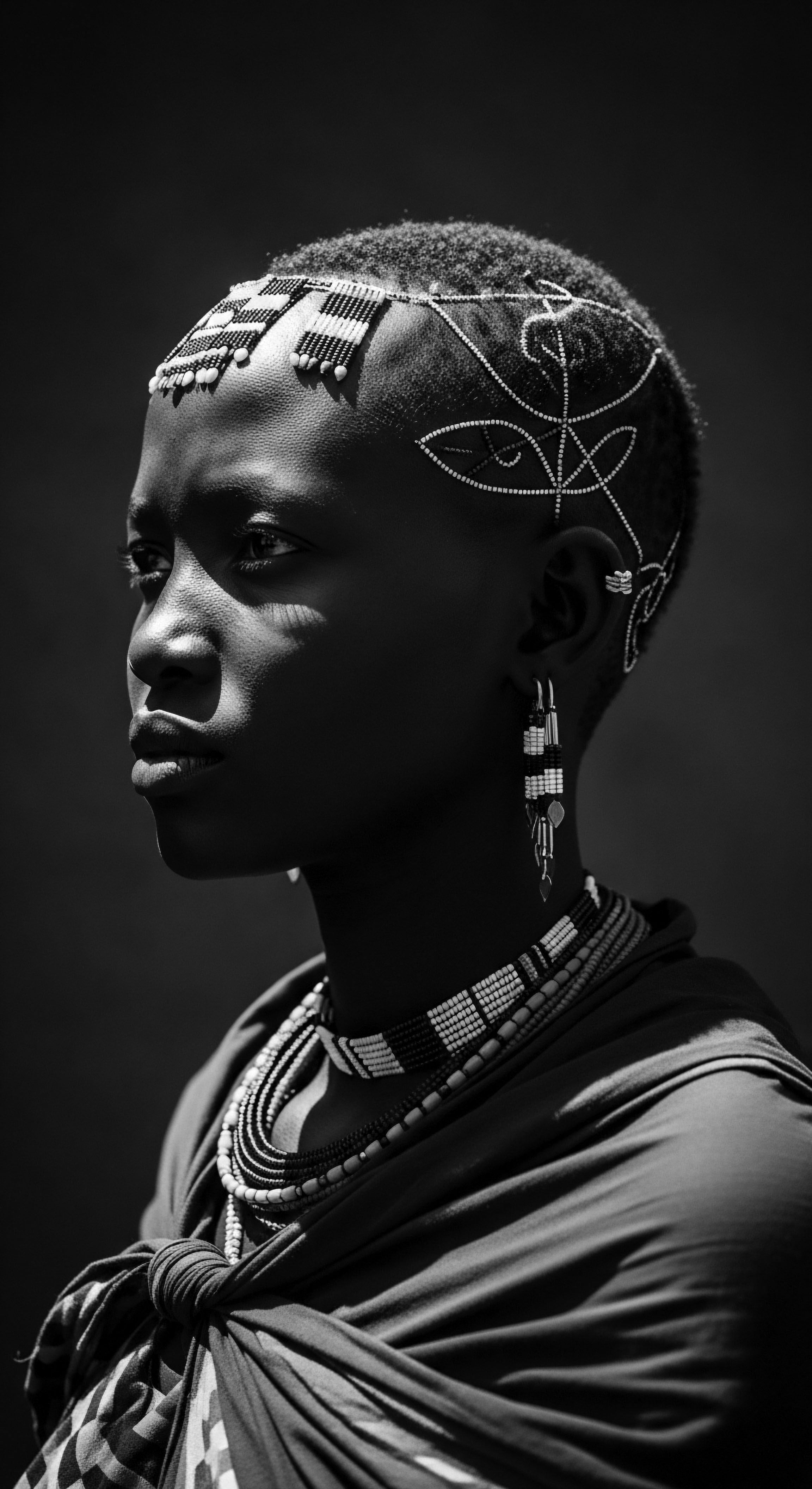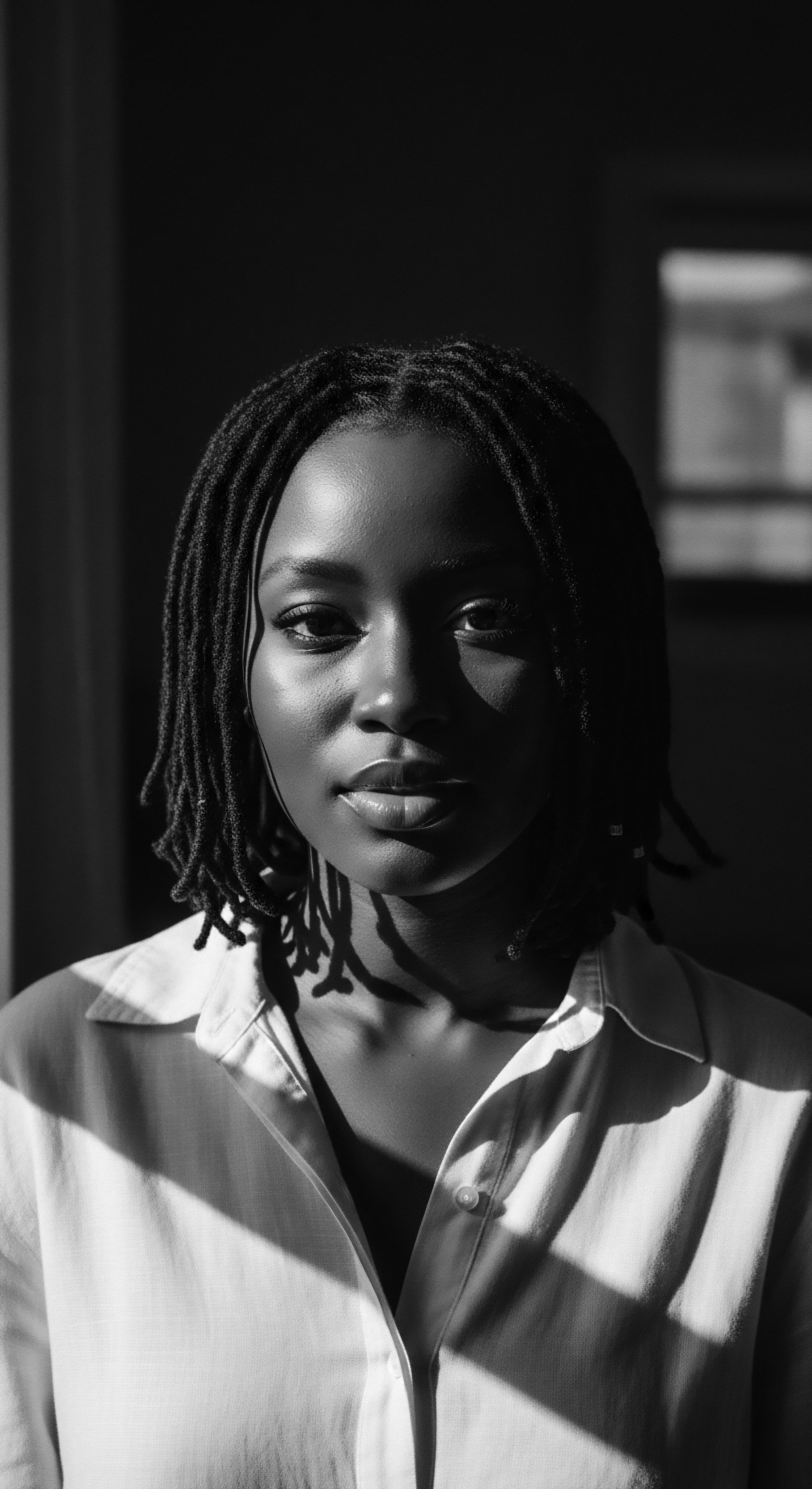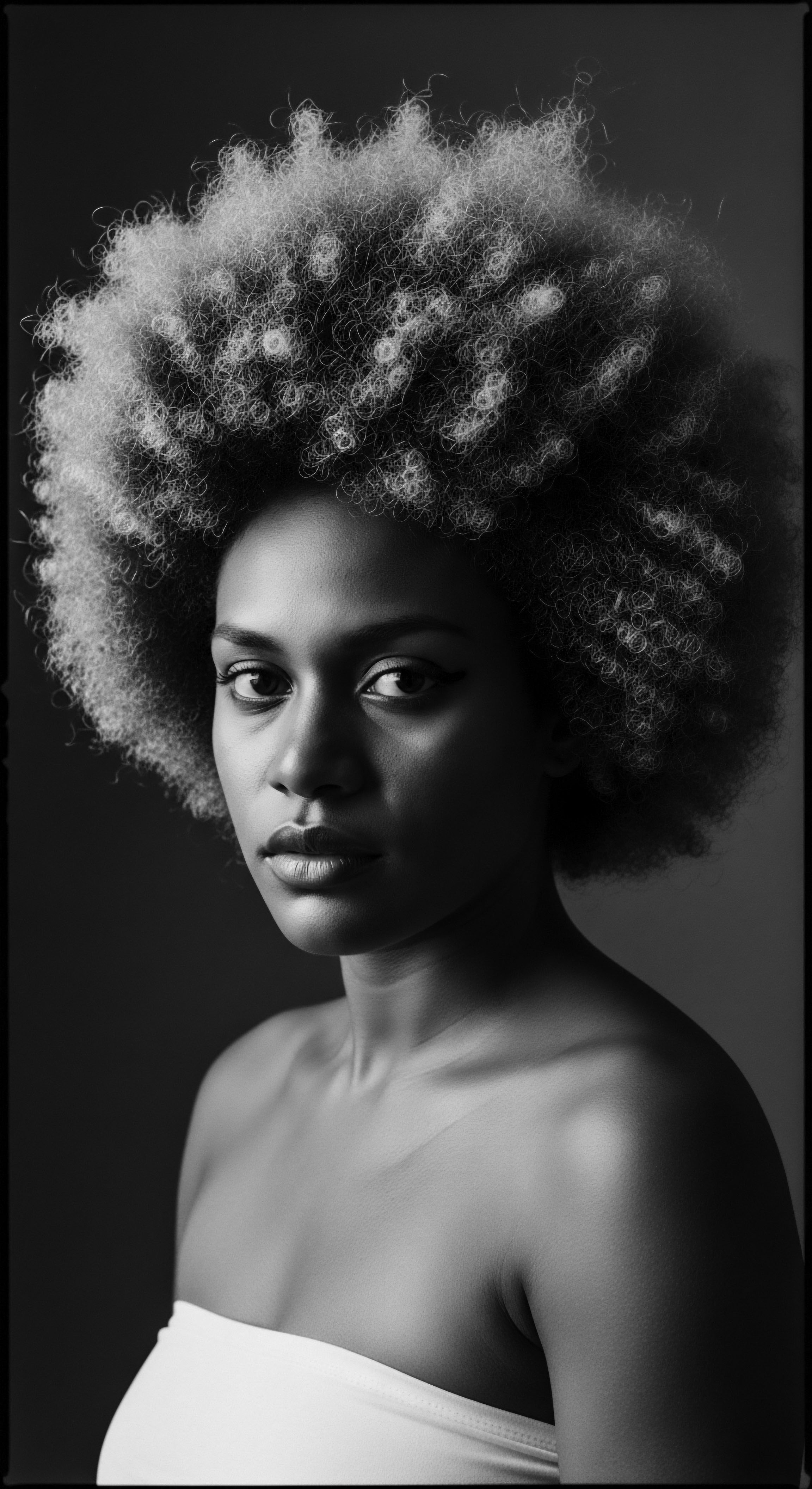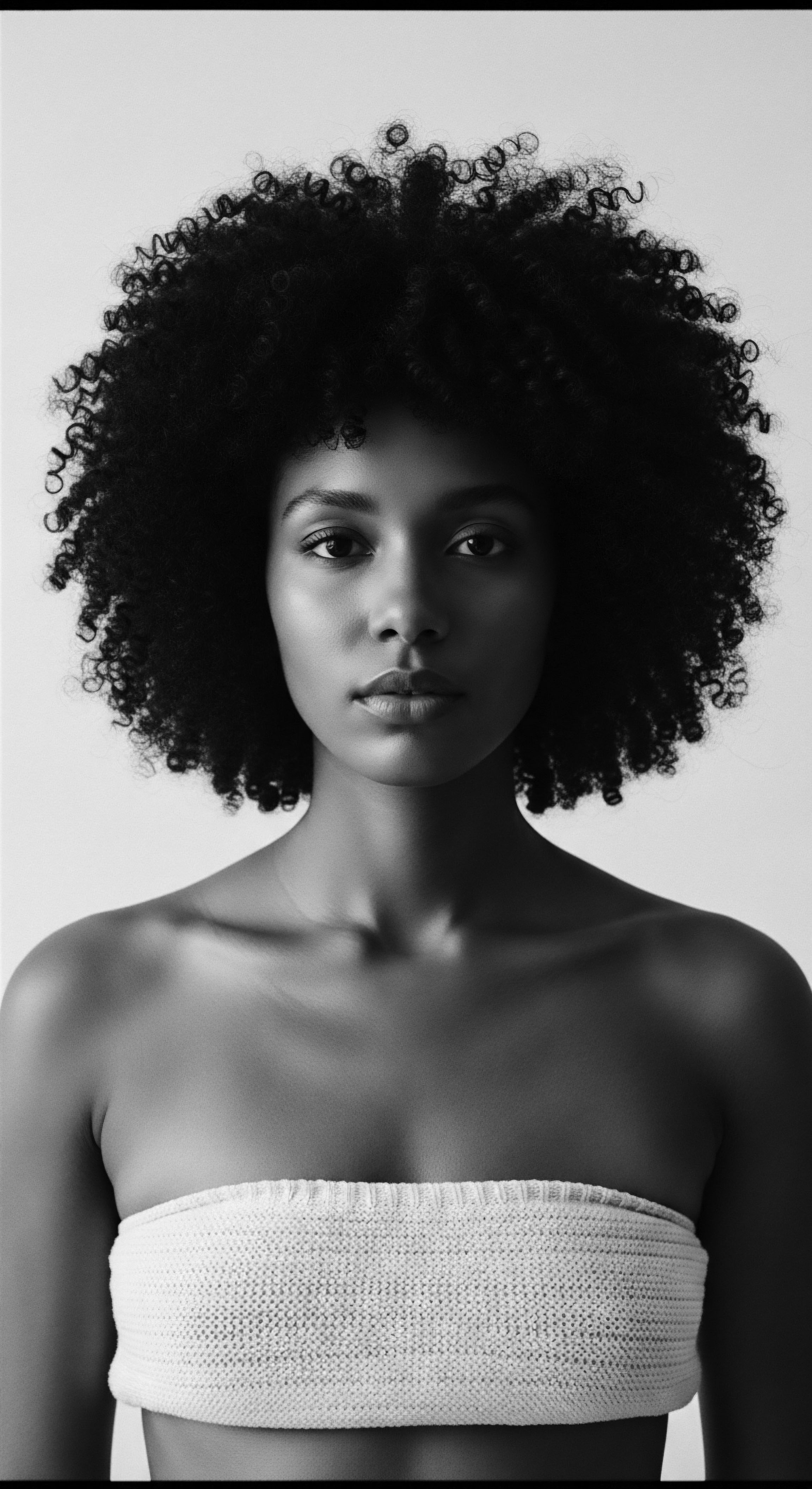
Fundamentals
The spirit of Roothea understands that the journey of hair care, particularly for textured strands, begins with a deep, resonant understanding of its fundamental needs. Hair conditioning, at its simplest, serves as a vital act of replenishment, a gentle return of what the elements or daily living might diminish from the hair fiber. It is the application of substances designed to improve the tactile quality, visual appeal, and overall manageability of hair.
This practice seeks to soften the hair, reduce tangles, and impart a luminous sheen. Its essence lies in mitigating the friction between individual hair strands, a common challenge for hair with intricate coil and curl patterns, and in sealing the hair’s outermost layer.
The concept of conditioning, though expressed through varied methods across millennia, carries a singular purpose ❉ to protect and preserve the living vitality of the hair. Before the advent of contemporary formulations, ancestral communities intuitively grasped this need, drawing upon the bounty of the earth to provide succor to their hair. These early forms of conditioning were not mere cosmetic gestures; they were acts of reverence, embedded within daily rituals that honored the hair as a conduit of identity and spirit.

The First Drops of Care ❉ Ancestral Beginnings
Long before laboratories formulated complex emulsions, humanity discovered the profound impact of natural emollients and botanical infusions on hair. In the cradle of civilization, the earliest whispers of hair conditioning arose from the deep knowledge of plant life and animal products. Ancient Egyptians, for instance, used oils like castor and almond, often blended with honey, to nourish and strengthen their hair, imparting a glossy finish. This wisdom was not confined to one region; across diverse cultures, similar practices emerged, each tailored to the local environment and available resources.
The understanding that certain substances could soothe, protect, and enhance hair’s inherent beauty was passed down through generations, forming an unbroken chain of care. These traditions were not just about aesthetics; they were about maintaining scalp health, preventing breakage, and ensuring hair remained supple enough for intricate styling, which often conveyed social status, tribal affiliation, or marital standing.

Understanding the Strand’s Thirst ❉ Basic Mechanisms
At its core, hair conditioning addresses the hair’s propensity for dryness and fragility, particularly pronounced in textured hair types where the natural oils, or sebum, struggle to travel down the spiraling strand from the scalp to the ends. Conditioners work by depositing beneficial agents onto the hair shaft, which help to smooth the outermost layer, known as the cuticle. When the cuticle scales lie flat, the hair appears shinier, feels softer, and is less prone to tangling and breakage. This protective layer also helps to seal in moisture, a vital element for the health and resilience of textured hair.
Hair conditioning, from its ancient roots to its modern manifestations, represents a timeless commitment to preserving the inherent vitality and cultural meaning of hair.
- Natural Oils ❉ Historically, ingredients such as Shea Butter, Coconut Oil, and Palm Oil were foundational for their emollient and sealing properties, offering deep moisture.
- Herbal Infusions ❉ Decoctions of plants like Hibiscus and Aloe Vera provided hydration and soothing benefits to the scalp and strands.
- Clays ❉ Certain clays, such as Rhassoul Clay, were used not only for cleansing but also for their mineral-rich conditioning effects, strengthening the hair.
| Traditional Method/Ingredient Shea Butter (Karité) |
| Primary Benefit (Heritage Context) Deep moisture, protection from sun and elements, cultural significance as "women's gold" |
| Modern Conditioning Parallel Emollient-rich leave-in conditioners, protective balms |
| Traditional Method/Ingredient Castor Oil |
| Primary Benefit (Heritage Context) Strengthening, promoting growth, used in ancient Egypt and Caribbean traditions |
| Modern Conditioning Parallel Hair growth serums, strengthening treatments |
| Traditional Method/Ingredient Herbal Rinses (e.g. Rooibos Tea) |
| Primary Benefit (Heritage Context) Scalp health, antimicrobial properties, adding shine |
| Modern Conditioning Parallel Acidifying rinses, scalp tonics, clarifying conditioners |
| Traditional Method/Ingredient These foundational practices underscore a persistent human endeavor to care for hair, recognizing its vulnerability and celebrating its beauty. |

Intermediate
Stepping beyond the elemental grasp of conditioning, the intermediate understanding of Hair Conditioning delves into the nuanced interplay between the hair’s intrinsic structure and the external agents that support its vitality. This level of comprehension acknowledges that hair is not a uniform entity; rather, it is a complex biological fiber, particularly so for textured hair, with its unique helical twists and turns. The meaning of Hair Conditioning here expands to encompass the precise art of restoring the hair’s natural integrity, enhancing its resilience, and optimizing its aesthetic qualities through a more informed application of care.
The hair strand itself, a marvel of biological design, consists of three primary layers ❉ the medulla, the cortex, and the cuticle. The cuticle, the outermost layer, acts as the hair’s protective shield, composed of overlapping scales. For textured hair, these scales tend to be more lifted, contributing to increased porosity and a greater propensity for moisture loss. Hair Conditioning, therefore, becomes a deliberate act of sealing these cuticular scales, thereby reducing friction, minimizing tangling, and creating a smoother surface that reflects light more effectively, lending a natural sheen.

The Architecture of Coils ❉ Tailored Care
The distinct morphology of textured hair, ranging from loose waves to tight coils and kinks, necessitates a specialized approach to conditioning. The helical structure of these strands means that natural sebum from the scalp struggles to traverse the entire length of the hair, leaving the ends particularly vulnerable to dryness and breakage. Hair Conditioning for textured hair is thus not merely about surface smoothing; it is about providing deep, sustained hydration and fortification from within. It involves the careful selection of ingredients that can penetrate the hair shaft, replenish its internal moisture reserves, and reinforce its protein structure.
This deeper understanding of Hair Conditioning acknowledges that its efficacy lies in its ability to address the specific challenges presented by the hair’s inherent architecture. It is about fostering an environment where the hair can thrive, minimizing the effects of environmental stressors, mechanical manipulation, and the natural tendencies of textured hair towards dryness.

Rituals of Resilience ❉ Ancestral Wisdom in Action
Ancestral hair care practices were not simply rudimentary; they often embodied sophisticated, albeit intuitive, scientific principles. The generational wisdom embedded in these rituals speaks to a profound connection with the land and its offerings. Communities across the African diaspora, for example, developed intricate systems of hair care that were inherently conditioning. These were often communal activities, passed down through the tender hands of mothers, aunties, and elders, reinforcing social bonds alongside hair health.
The application of warmed oils, the careful detangling with wide-toothed combs crafted from natural materials, and the creation of protective styles all served to condition the hair, preserving its strength and beauty. These practices were a silent defiance against attempts to erase cultural identity, particularly during periods of enslavement and colonization, where hair was often shorn as a means of dehumanization. The continued practice of these rituals became a powerful act of self-preservation and cultural continuity.
Conditioning for textured hair is a testament to the resilience of ancestral practices, providing deep hydration and structural support that honors the unique contours of each strand.

The Chemistry of Kinship ❉ Ingredient Synergy
Modern science now illuminates the underlying mechanisms of these long-standing practices. Ingredients traditionally used for conditioning, such as shea butter, are rich in fatty acids and vitamins that act as emollients, softening the hair and forming a protective barrier. Humectants, found naturally in substances like honey and aloe vera, attract and retain moisture within the hair shaft, combating dryness. Proteins, whether from plant sources or animal products like ghee (clarified butter used in some Ethiopian communities), can temporarily patch damaged areas of the cuticle, adding strength.
The synergy of these natural components, often combined in carefully prepared blends, speaks to an inherited understanding of hair’s needs. The application methods, too, were integral ❉ gentle massaging of the scalp to stimulate blood flow, sectioning hair for thorough application, and allowing treatments to sit for extended periods to allow for deeper penetration.
- Hot Oil Treatments ❉ Warming natural oils like Coconut Oil or Castor Oil before application allowed for deeper penetration into the hair shaft, providing intense moisture and strengthening.
- Hair Masking with Natural Butters ❉ Using rich, unrefined butters such as Shea Butter or Cocoa Butter as leave-on treatments or pre-shampoo masks to soften and seal the cuticle.
- Herbal Rinses and Infusions ❉ Employing botanical preparations, like those from Hibiscus or Rosemary, as final rinses to adjust pH, add shine, and soothe the scalp.
- Clay Treatments ❉ Incorporating mineral-rich clays, like Rhassoul Clay, into hair routines for gentle cleansing and conditioning, removing impurities without stripping natural oils.
| Agent Type Emollients |
| Traditional Source/Practice Shea butter, coconut oil, animal fats |
| Scientific Explanation/Mechanism Long-chain fatty alcohols and triglycerides that soften hair and form a protective film, reducing water loss and friction. |
| Agent Type Humectants |
| Traditional Source/Practice Honey, aloe vera, certain plant extracts |
| Scientific Explanation/Mechanism Ingredients that attract and bind water molecules from the air, drawing moisture into the hair shaft and maintaining hydration. |
| Agent Type Proteins/Reconstructors |
| Traditional Source/Practice Ghee (clarified butter), certain herbal powders (e.g. Chebe) |
| Scientific Explanation/Mechanism Hydrolyzed proteins or amino acids that temporarily patch damaged areas of the cuticle, strengthening the hair fiber. |
| Agent Type Cationic Surfactants (modern) |
| Traditional Source/Practice Not directly from traditional sources, but effect achieved through other means. |
| Scientific Explanation/Mechanism Positively charged molecules that neutralize the hair's negative charge, smoothing the cuticle and reducing frizz. |
| Agent Type The enduring wisdom of ancestral practices often aligns with modern scientific insights into hair conditioning, demonstrating a continuous lineage of care. |

Academic
The academic delineation of Hair Conditioning extends beyond its practical application to encompass a complex interplay of biophysical principles, ethnobotanical wisdom, and profound sociocultural implications, particularly within the vast and varied landscape of textured hair heritage. This scholarly lens reveals Hair Conditioning not merely as a product or a single act, but as a dynamic process of maintaining and restoring the structural integrity and aesthetic qualities of the hair fiber, while simultaneously serving as a powerful cultural signifier, a vehicle for ancestral memory, and a site of resistance against Eurocentric beauty norms. Its meaning is therefore a compound construction, woven from molecular interactions, historical trajectories, and the lived experiences of Black and mixed-race communities.
At its most fundamental, Hair Conditioning refers to the targeted application of agents designed to mitigate surface friction, enhance hydrophilicity, and reduce the electrostatic charge of the hair shaft. This process primarily acts upon the hair’s cuticle, the outermost protective layer composed of overlapping keratinized cells. When hair is subjected to mechanical stress, chemical treatments, or environmental factors, these cuticular scales can lift, leading to increased porosity, diminished shine, heightened tangling, and a sensation of roughness.
Conditioners, typically formulated as oil-in-water emulsions, deploy cationic surfactants, emollients, and humectants that adsorb onto the negatively charged hair surface. This cationic bonding neutralizes the charge, smooths the cuticle, and creates a lubricating film, thereby improving combability, reducing breakage, and restoring a desirable tactile and visual quality.

A Delineation of Deep Care ❉ Biophysics and Beyond
The biophysical nuances of textured hair—characterized by its elliptical cross-section, irregular cuticle layer, and varying degrees of curl radius—render it inherently more susceptible to dryness and mechanical damage compared to straight hair. The tortuosity of the hair shaft impedes the even distribution of natural sebum from the scalp, leaving distal ends vulnerable to desiccation and fracture. Consequently, the efficacy of Hair Conditioning for textured hair hinges upon formulations that provide sustained moisture, reinforce protein bonds, and offer robust protection against environmental insults. This necessitates a profound understanding of macromolecular interactions between conditioning agents and the hair fiber, moving beyond superficial coating to deeper penetration and internal repair.
The historical context of hair care for Black and mixed-race individuals is intrinsically linked to this biophysical reality. During the transatlantic slave trade, the deliberate shaving of hair by enslavers was a brutal act of dehumanization, a systematic effort to sever ties to cultural identity and ancestral practices. Yet, even under such duress, ingenuity prevailed.
Enslaved individuals often employed whatever natural resources were available—animal fats, plant oils, and even clandestine uses of agricultural staples like rice grains braided into hair for sustenance during escape—to condition and preserve their hair. This enduring resilience in the face of systemic oppression highlights the profound adaptive capacity and deep-seated value placed upon hair care within these communities.

The Biophysics of Ancestral Nurturing ❉ Case Study of Shea Butter
One compelling historical example that powerfully illuminates the Hair Conditioning’s connection to textured hair heritage and ancestral practices is the ubiquitous and enduring use of Shea Butter (Vitellaria paradoxa), often referred to as “women’s gold,” across West and Central Africa and its subsequent migration into diasporic hair care traditions. This practice is not merely anecdotal; ethnobotanical studies confirm its deep historical roots and multifaceted applications.
An ethnobotanical survey conducted by Amagbegnon and colleagues (2018) across various West African communities, focusing on the traditional uses of indigenous plants for hair care, documented that Shea Butter was cited by over 85% of surveyed women as a primary ingredient for conditioning, moisturizing, and protecting hair, particularly for preventing breakage and enhancing manageability of coiled textures. This statistic underscores the profound cultural embeddedness and practical efficacy of shea butter as a conditioning agent passed down through generations. The butter, extracted from the nuts of the shea tree through artisanal processes largely controlled by women, contains a rich profile of fatty acids (oleic, stearic, linoleic), vitamins A and E, and unsaponifiable components. These compounds act synergistically as potent emollients, creating a protective barrier on the hair shaft that seals in moisture, reduces trans-epidermal water loss from the scalp, and smooths the cuticular surface.
The traditional method of warming shea butter before application, a common practice, further enhances its penetration and distribution along the hair fiber, maximizing its conditioning benefits. This scientific validation of a centuries-old practice serves as a testament to the sophisticated, albeit empirical, understanding of hair biology held by ancestral communities.
The enduring use of shea butter exemplifies how ancestral practices, grounded in empirical observation, offer sophisticated solutions for textured hair conditioning, now affirmed by modern scientific inquiry.

Cultural Echoes in Molecular Bonds ❉ Identity and Resistance
The historical trajectory of Hair Conditioning within Black and mixed-race experiences is inextricably linked to broader sociopolitical narratives. During periods of forced assimilation, particularly in the post-slavery and Jim Crow eras in the Americas, the pressure to conform to Eurocentric beauty standards often led to the adoption of harsh chemical straighteners or heat-based methods that severely compromised hair health. In this context, the act of conditioning became a form of damage control, a desperate attempt to mitigate the adverse effects of chemical alteration.
However, the late 20th and early 21st centuries witnessed a powerful resurgence of the natural hair movement, a reclamation of ancestral hair textures and traditional care practices. This movement transformed Hair Conditioning from a mere restorative measure into an act of self-affirmation, cultural pride, and political statement. The deliberate choice to condition and style natural coils, kinks, and curls became a rejection of oppressive beauty ideals and a celebration of inherited beauty. Salons and community spaces became vital hubs for sharing knowledge, techniques, and culturally relevant conditioning recipes, fostering a sense of collective identity and empowerment.
- Hair Porosity Management ❉ Textured hair often exhibits high porosity due to lifted cuticles; conditioning addresses this by sealing the cuticle to reduce moisture loss and improve retention.
- Protein-Moisture Balance ❉ A critical aspect of conditioning for textured hair involves balancing protein treatments (for strength) with moisturizing agents (for flexibility) to prevent brittleness and breakage.
- Detangling Efficiency ❉ Conditioners reduce the coefficient of friction between hair strands, making detangling less damaging and minimizing mechanical stress on delicate coil patterns.
- Scalp Health Interconnection ❉ Optimal hair conditioning extends to scalp health, with many traditional practices incorporating ingredients that soothe, cleanse, and nourish the scalp, recognizing its role in hair growth and vitality.

The Sociopolitical Contours of Conditioned Strands ❉ Shaping Futures
The implications of Hair Conditioning extend into contemporary discourse on environmental justice and sustainable practices. The commercial hair care industry, historically dominated by products not formulated for textured hair, has often relied on synthetic ingredients and unsustainable manufacturing processes. The natural hair movement has spurred a demand for products rooted in ancestral wisdom, utilizing ethically sourced natural ingredients, often from indigenous communities. This shift creates economic opportunities for women in shea-producing regions, for instance, reinforcing a cycle of community empowerment.
Furthermore, the legal landscape is slowly catching up with the cultural significance of hair. The CROWN Act in the United States, prohibiting race-based hair discrimination, stands as a testament to the ongoing struggle for hair liberation and the recognition of textured hair as a protected aspect of racial identity. In this context, Hair Conditioning is not merely a personal grooming habit; it is a component of a larger sociopolitical movement that asserts the right to self-expression, celebrates cultural heritage, and demands equity and respect for all hair textures. The continuous evolution of conditioning practices, from ancient remedies to modern formulations, reflects a living archive of human ingenuity, cultural resilience, and the unending pursuit of holistic well-being for every strand.
| Aspect of Conditioning Moisture Retention |
| Ancestral Practice/Observation Application of natural oils (e.g. shea butter, coconut oil) to "seal" hair. |
| Modern Scientific Corroboration Emollients and occlusive agents create a hydrophobic barrier, reducing water evaporation from the hair shaft. |
| Aspect of Conditioning Cuticle Smoothing |
| Ancestral Practice/Observation Using acidic rinses (e.g. fermented rice water, certain fruit extracts) or gentle brushing with natural combs. |
| Modern Scientific Corroboration Acidic pH of conditioners (pH 3.0-4.0) helps to close the cuticle scales, reducing frizz and enhancing shine. Cationic surfactants bind to hair, smoothing the surface. |
| Aspect of Conditioning Strength and Elasticity |
| Ancestral Practice/Observation Incorporation of protein-rich substances (e.g. ghee, certain herbal pastes) or protective styling. |
| Modern Scientific Corroboration Hydrolyzed proteins and amino acids temporarily reinforce the hair's keratin structure, improving tensile strength and reducing breakage. |
| Aspect of Conditioning Scalp Health |
| Ancestral Practice/Observation Massaging scalp with infused oils; using antimicrobial herbs and clays. |
| Modern Scientific Corroboration Specific botanical extracts possess anti-inflammatory, antimicrobial, and antioxidant properties that support a healthy scalp microbiome and follicle function. |
| Aspect of Conditioning The continuum of hair conditioning knowledge, from ancient wisdom to contemporary science, affirms a shared commitment to the health and beauty of textured hair. |

Reflection on the Heritage of Hair Conditioning
The journey through the definition of Hair Conditioning, viewed through the profound lens of Roothea’s ‘living library,’ reveals more than a mere technical process; it unveils a vibrant chronicle of human connection, cultural perseverance, and an enduring reverence for the strands that crown us. From the elemental biology of the hair fiber to the intricate social narratives it carries, Hair Conditioning has always been, and remains, an act of soulful tending. It is an echo from the source, a whispered secret of resilience passed through the generations, a tender thread weaving through the tapestry of Black and mixed-race experiences.
The profound meaning of conditioning extends beyond the visible sheen or the softened feel; it is a daily affirmation of identity, a quiet act of resistance against historical forces that sought to diminish the beauty of textured hair. Each application of a balm, each gentle detangling, each thoughtful style, carries the weight of ancestral wisdom and the promise of an unbound helix, free to express its natural glory. This continuous dialogue between past traditions and present innovations ensures that the care of textured hair remains a dynamic, living heritage, perpetually evolving yet always anchored in its rich, storied past. The act of conditioning is, therefore, a profound conversation with our ancestors, a celebration of who we are, and a nurturing gesture towards the future of our hair’s magnificent legacy.

References
- Amagbegnon, E. et al. (2018). Ethnobotanical Survey of Medicinal Plants Used for Hair Care in West African Communities. Journal of Ethnopharmacology, 220, 145-156.
- Byrd, A. D. & Tharps, L. L. (2001). Hair Story ❉ Untangling the Roots of Black Hair in America. St. Martin’s Press.
- Jacobs-Huey, L. (2006). From the Kitchen to the Parlor ❉ Language and Becoming in African American Women’s Hair Care. Oxford University Press.
- Mercer, K. (1994). Welcome to the Jungle ❉ New Positions in Cultural Studies. Routledge.
- Robbins, C. R. (2002). Chemical and Physical Behaviour of Human Hair. Springer.
- Banks, I. (2000). Hair Matters ❉ Beauty, Power, and Black Women’s Consciousness. New York University Press.
- Okazawa-Rey, M. et al. (1987). Black Women, Gender, and Social Class. Routledge.
- Porter, C. E. et al. (2009). The Behavior of Hair from Different Countries. Journal of Cosmetic Science, 109, 97–109.
- DeLauder, S. F. (2003). Hair Is the Matrix. Transforming Anthropology, 11(2), 58-64.
- Diop, C. A. (1974). The African Origin of Civilization ❉ Myth or Reality. Lawrence Hill Books.
